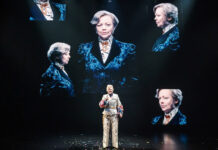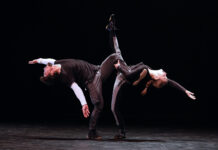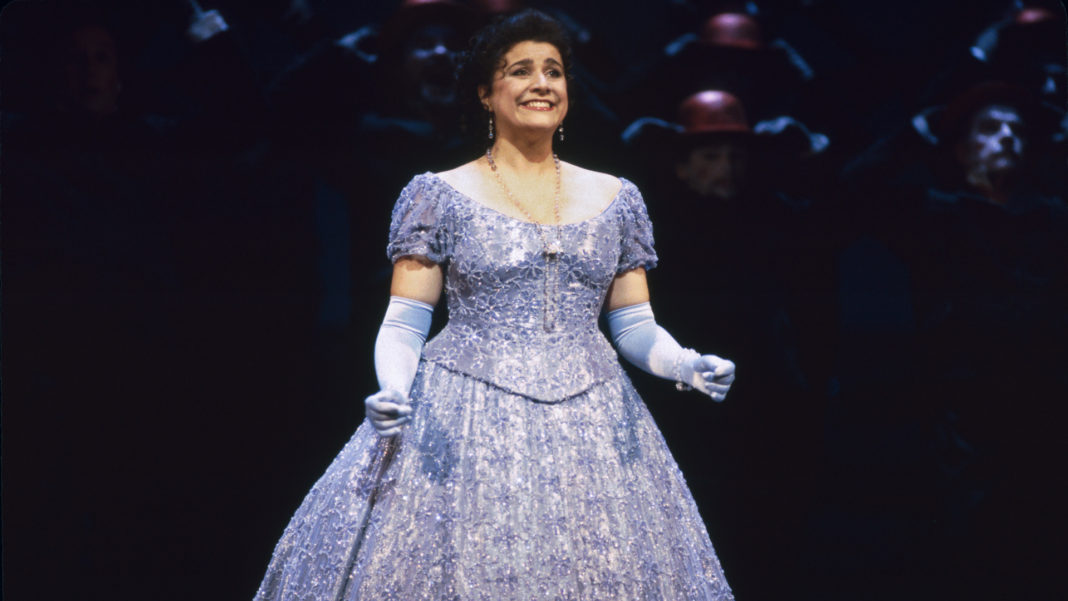We can all use some lightness and comedy in our lives. Perhaps that’s why the theme for Week 32 at the Met is Operatic Comedies. Not only can you expect some laughs this week, the productions being offered mark several milestones: the first ever production of Rossini’s La Cenerentola at the Met; the Met debuts of Tony Award winners Kelli O’Hara, Bartlett Sher and Susan Stroman and the final performances by Renée Fleming in Der Rosenkavalier.
Each production becomes available at 7:30 PM EDT/4:30 PM PDT on the Metropolitan Opera website. Every opera remains available for 23 hours. They are heavily promoting their Met Stars Live in Concert series and recently announced the cancellation of the full 2020-2021 season, so you’ll have to go past those announcements and promos to find the streaming productions. Schedules and timings may be subject to change.
If you read this column earlier enough on October 19th, you might still have time to catch the 2010-2011 season production of Don Pasquale that concludes last week’s Donizetti Week.
Here is the line-up for Week 32 at the Met:
Monday, October 19 – Rossini’s Il Barbiere di Siviglia
Conducted by Maurizio Benini; starring Joyce DiDonato, Juan Diego Flórez, Peter Mattei, John Del Carlo and John Relyea. This Bartlett Sher production is from the 2006-2007 season. This is an encore presentation of the production that was made available on March 31st.
Gioachino Rossini’s Il Barbiere di Siviglia (The Barber of Seville) had its world premiere in 1816 in Rome. The opera is based on the new 1775 comedy by Beaumarchais of the same name. The libretto was written by Cesare Sterbini.
In this comedic opera, Count Almaviva is in love with the delightful Rosina. As he’s a Count, he wants to make sure her love is true and anchored in her passion for him, not the fact that he’s a Count.
In order to be sure, he pretends to be student with no money. Regardless of his efforts, Bartolo, who serves as Rosina’s guardian, will make sure no one will woo Rosina and win. Bartolo, however, doesn’t know that Almaviva has a secret weapon, a cunning man named Figaro who is…the barber.
This production marked the debut of Tony Award-winner (and 9-time nominee) Bartlett Sher at the Metropolitan Opera. In Anthony Tommasini’s review in the New York Times he hailed Sher’s production.
“For the inventive, breezy new production of Il Barbiere di Siviglia at the Metropolitan Opera, which opened on Friday night and boasts a winning cast, the director Bartlett Sher, making his Met debut, has embraced the opera’s atmosphere of intrigue and subterfuge. Michael Yeargan’s set is an abstract matrix of movable doors, stairwells and potted orange trees that characters lurk behind as they listen in on conversations. Yet this is in no way an updated production. The costume designer, Catherine Zuber, has dressed the characters in colorful and sexy period garb with comic touches, like the disheveled, curly red wig worn by Rosina, the young heroine.
“If not updated, the opera is freshened up by Mr. Sher, bringing his perspective as an acclaimed theater director best known to New Yorkers for The Light in the Piazza.”
Tuesday, October 20 – Lehár’s The Merry Widow
Conducted by Sir Andrew Davis; starring Renée Fleming, Kelli O’Hara, Nathan Gunn, Alek Shrader and Thomas Allen. This Susan Stroman production is from the 2014-2015 season. This is an encore presentation of the production that was made available on April 23.
Franz Lehár’s opera had its world premiere in 1905 in Vienna. The libretto is based on Henri Meilhac’s 1861 comedy, L’attaché d’ambassade (The Embassy Attaché). Viktor Léon and Leo Stein wrote the libretto.
When Hanna Glawari, a young woman, becomes a widow, the Ambassador wants her to re-marry someone who lives in their province of Pontevedro so her wealth can remain in the country. The last thing he wants is for her to fall for a Frenchman. Meanwhile his own wife, Valencienne, is having an affair with Camille, Count de Rosillon – a Frenchman.
Hanna claims to soon be marrying Camille, hoping to preserve Valencienne’s reputation. Circling all of this is Count Danilo, Hanna’s ex who refuses to marry her for her money. When she announces her engagement to Camille, Danilo is forced to reconcile his feelings.
This is another production directed by a Broadway veteran with five-time Tony Award winner Susan Stroman (The Producers), making her Metropolitan Opera debut. Also appearing at the Met for the first time is Tony Award winner Kelli O’Hara (The King and I).
Of O’Hara, Anthony Tommasini wrote in his New York Times review, “Ms. O’Hara’s ardent fans (put me in the front ranks of that group) will be delighted with the chance to hear her sing without the amplification requisite on Broadway. She is a vocalist with operatic training. And her tender voice carries nicely in the house — certainly as well as that of the gifted young tenor Alek Shrader, who sounded a little pinched as Camille in his scenes with her.”
Wednesday, October 21 – Mozart’s Così fan tutte
Conducted by David Robertson; starring Amanda Majeski, Serena Malfi, Kelli O’Hara, Ben Bliss, Adam Plachetka and Christopher Maltman. This Phelim McDermott is from the 2017-2018 season. This is an encore presentation of the production that was made available on April 12th.
Mozart’s Cosí fan tutte had its world premiere in Vienna in 1790. Lorenzo Da Ponte, who wrote the libertti for The Marriage of Figaro and Don Giovanni, wrote the libretto.
Ferrando and Guglielmo are vacationing with their fiancées, Dorabella and Fiordiligi. They are sisters. Don Alfonso challenges the men to a bet revolving around the women and their ability to be faithful. Using disguise, deception and a wicked sense of humor, Mozart’s opera ends happily ever after for one and all.
This production transports the original Naples setting in the 18th century to Brooklyn in the 20th century. Specifically, McDermott places the opera at an amusement park filled with the attractions you’d expect to set at the side show: sword swallowers, a bearded lady, a fire eater, a strongman and a contortionist.
Anthony Tommasini seemed a bit torn about the effectiveness of this setting. In his New York Times review he said, “I have never seen a production that completely cracks the code of Così, and for all its charms and insights, this production also comes up short. Mr. McDermott’s concept doesn’t explore the unsettling elements as much as some productions I’ve seen. But one thing it gets right is the role of sexual desire as a motivator for these lovers. To that end, moving the story to the 1950s, when proper young people refrained from premarital sex, and setting it in an amusement park, where the couples are on vacation, work well.”
Thursday, October 22 – Rossini’s La Cenerentola
Conducted by James Levine; starring Cecilia Bartoli, Ramón Vargas, Simone Alaimo and Alessandro Corbelli. This Cesare Lievi production is from the 1997-1998 season.
Gioachino Rossini’s opera of the Cinderella story is based on Charles Perrault’s Cendrillon. The libertto, by Jacopo Ferretti, was based on two previous libretti for operas based on the same story: Charles-Guillaume Étienne’s libretto for Nicolas Isouard’s 1810 opera Cendrillon and Francesco Fiorini’s libretto for Stefano Pavesi’s 1814 opera, Agatina o La virtú premiata. La Cenerentola had its world premiere in 1817 in Rome.
The story is exactly what you expect. After being relegated to chores around the house by her Stepmother and her Stepsisters, Cinderella dreams of going to the Prince’s ball. They mock her before leaving themselves for the event. Cinderella’s fairy godmother appears to make her dream a reality, but only if she returns by midnight.
This was the first-ever production of La Cenerentola at the Met. There was one, and truly only one, reason for them to finally mount Rossini’s opera: Cecilia Bartoli. She included an aria from the opera on her first solo album in 1989 called Rossini Arias.
Mark Swed, writing in the Los Angeles Times, said of Bartoli’s performance in this production, “Still only 31 and a singer known for her insistence on respecting the natural limits of her supple but not large voice, Bartoli remains utterly fresh-sounding. So smooth and whole is the musical line that the florid decorations of Rossini’s coloratura never seem like display but more like a cat purring.
“Remarkable as her incomparable technique may be, Bartoli also integrates the singing–and purring it seems all the more–into a complete stage persona. If the Looney Tunes artists were still at it, they would have the perfect opera cat in Bartoli. She has a feline sense of surprising movement. Her attention is bright and seems scaled to the micro-second. She simply owns the stage, the way a cat owns its surroundings.”
Friday, October 23 – Verdi’s Falstaff
Conducted by James Levine; starring Mirella Freni, Barbara Bonney, Marilyn Horne, Bruno Pola and Paul Plishka. This revival of Franco Zeffirelli’s 1964 production is from the 1992-1993 season. This is an encore presentation of the production that was made available on July 24th.
Two of Shakespeare’s play served as the inspiration for Verdi’s Falstaff: The Merry Wives of Windsor and sections from Henry IV Parts 1 and 2. Arrigo Boito adapted the plays to create the libretto. Falstaff had its world premiere in 1893 at La Scala in Milan. This was Verdi’s final opera and only his second comedic opera.
Simply put, Sir John Falstaff tries everything he can to woo two married woman so he can assume their husband’s vast fortunes. He’s rather bumbling in his efforts and the machinations in place to thwart his endeavors leave him with nothing short of a major comeuppance.
Edward Rothstein, writing for The New York Times, seemed to thoroughly enjoy the production. And he was very pleased with Plishka’s performance as the title character:
“Mr. Plishka gave the role an almost touchingly human quality. In the astonishing first scene aria, in which Falstaff declares his ambitions, mocks the idea of honor and praises his belly, there were few mannerisms or exaggerations. Mr. Plishka played it straight; he was a Falstaff almost enticingly full of himself. His voice was not often handsome (why should it have been?) but it was large, weighty and in character.”
Saturday, October 24 – Rossini’s Le Comte Ory
Conducted by Maurizio Benini; starring Diana Damrau, Joyce DiDonato and Juan Diego Flórez. This Bartlett Sher production is from the 2010-2011 season. This is an encore presentation of the production that was made available on April 16th and September 15th.
Gioachino Rossini’s Le Comte Ory had its world premiere in Paris in 1828. The libretto was written by Eugène Scribe and Charles-Gaspard Delestre-Poirson who adapted a play they had written eleven years earlier. Rossini used some of the music he had composed for Il Viaggio a Reims, performed at the the coronation of Charles X, in this opera.
Count Ory and his companion Raimbaud disguise themselves as hermits to seduce women left behind during the Crusades while the men went to the Holy Land. The women are on their own. Lady Ragonde takes charge of Formoutiers castle and looks after Adèle, the sister of the castle’s lord. Ory and Raimbaud offer their assistance, but obviously have something else on their minds.
This was the very first production of Le Comte Ory at the Met. All three leads had previously appeared together in Rossini’s Il Barbiere di Siviglia under Sher’s direction four years earlier.
Here Sher uses an opera-within-an-opera conceit. It was one that Anthony Tommasini of the New York Times did not expect to like, “Nothing in Ory invites an opera-within-an-opera concept. Still, Rossini artificially turned two unrelated pieces into a completely reconceived opera, so the artifice of Mr. Sher’s staging is somehow resonant. Moreover, for all the antics, Mr. Sher takes Rossini’s characters and their romantic entanglements seriously and coaxes precise, nuanced performances from his gifted cast.”
Sunday, October 25 – Strauss’s Der Rosenkavalier
Conducted by Sebastian Weigle; starring Renée Fleming, Elīna Garanča, Erin Morley, Matthew Polenzani, Marcus Brück and Günther Groissböck. This Robert Carsen production is from the 2016-2017 season. This is an encore presentation of the production that was made available on April 19th.
It was in Dresden in 1911 that the world was first introduced to Richard Strauss’ Der Rosenkavalier. The libretto was written by Hugo von Hofmannsthal. Two sources served as inspiration for the opera: Moliere’s Monsieur de Pourceaugnac and the novel Les amours du chevalier de Fabulas by Louvet de Courvai.
Several relationships are tested in this comic opera. The Marschallin, having an affair with Octavian, a much younger count, feels that her age is becoming an issue not just for him, but for her. Baron Ochs is engaged to Sophie and he asks Octavian to deliver the customary silver rose to his bride-to-be. She, however, falls in love with Octavian. What will it take to sort out real love and who will find themselves together and who will be alone at the end of the opera?
With this production, Fleming retired the role of Marschallin from her repertoire as she gradually made her exit from full productions. Anthony Tommasini, writing in the New York Times, closed his review by stating, “Der Rosenkavalier is not just about the passage of time and aging, but also about the importance of knowing when to let something, or even someone, go — in all stages of life. Ms. Fleming may be letting go of opera productions. We’ll see. Predictability is not a significant component of diva DNA. But she can look forward to many years of concerts and other artistic projects. And she sang beautifully on this milestone night for her, and for opera.”
That’s the full line-up for Week 32 at the Met. Next week the theme will be Politics in Opera (befitting a week prior to our elections.) Have fun with this week’s operas and enjoy your week.
Photo: Cecilia Bartoli in La Cenerentola (Photo courtesy of Met Opera Archives)












How do I watch them please , did not see a place to sigh. Up?
e.nathanson@att.net
Eva:
In each of our columns we provide a link that takes you to the event. In the case of the Metropolitan Opera listings, that can be found at the end of the first sentence in the second paragraph. You’ll notice that “website” is a different color. By clicking on that word you will be taken to the Met Opera website. From there, as directed, you’ll need to scroll down to find each day’s opera. I hope this information helps. Let me know.